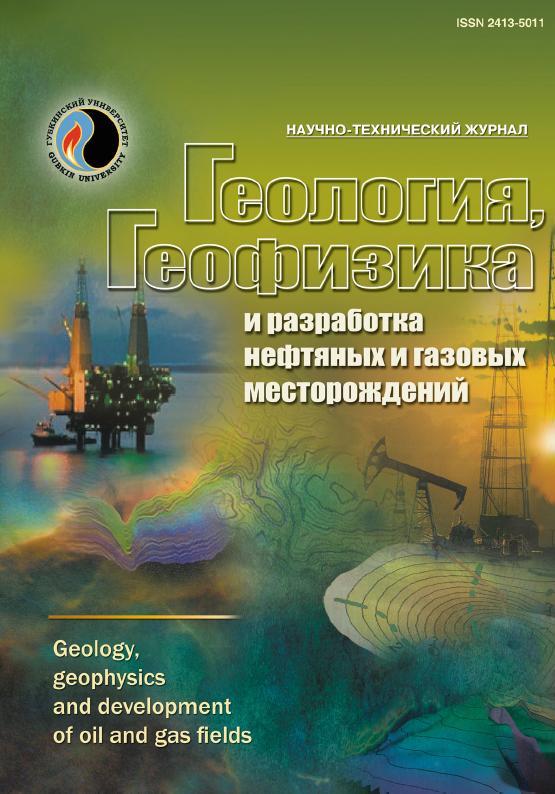Scientific and technical journal
«Geology, geophysics and development of oil and gas fields»
ISSN 2413-5011

Creation of synthetic copies of reservoir rocks core samples using 3D-printing technologies
UDC: 622.276.031:550.822.3
DOI: -
Authors:
1 Perm National Research Polytechnic University, Perm, Russia
Keywords: 3D-printing, additive technologies, reservoir rocks, lithological and petrophysical properties, filtration and capacitance properties, synthetic core, computed tomography, porous medium, parameters management
Annotation:
A comprehensive study of rock properties is a necessary step in the design of oil and gas fields development. The number of core samples for research is usually limited, and some tests lead to destruction or impossibility to reuse core samples. In this regard, an important task today is to study the possibilities of core replication for conducting a series of different orientation studies. Active development of additive technologies in combination with other technologies (computed tomography (CT), electron microscopy, etc.) provides an opportunity to reproduce the complex internal structure of rock pore space for their subsequent experimental study. Life-size synthetic core samples based on CT images were fabricated using LCD 3D-printing. The results of the experiments demonstrate the principal possibility of creating porous structures using LCD technology, however the target values were not achieved.
Bibliography:
1. Kochnev A.A., Oskolkov A.A., Krivoshchekov S.N. Analiz vozmozhnostey trekhmernoy pechati iskusstvennogo kerna gornykh porod // Geologiya, geofizika i razrabotka neftyanykh i gazovykh mestorozhdeniy. – 2023. – № 9(381). – S. 19–27. – DOI: 10.33285/2413-5011-2023-9(381)-19-27
2. Using resin-based 3D printing to build geometrically accurate proxies of porous sedimentary rocks / S. Ishutov, F. Hasiuk, D. Jobe, S. Agar // Groundwater. – 2018. – Vol. 56. – Is. 3. – Pp. 482–490. – DOI: 10.1111/gwat.12601
3. Characterization and microfabrication of natural porous rocks: From micro-CT imaging and digital rock modelling to micro-3D-printed rock analogs / R. Song, W. Yao, S. Sun, J.J. Liu // Journal of Petroleum Science and Engineering. – 2021. – Vol. 205. – P. 108827. – DOI: 10.1016/j.petrol.2021.108827
4. Simulation and validation of porosity and permeability of synthetic and real rock models using three-dimensional printing and digital rock physics / E. Ibrahim, M. Jouini, F. Bouchaala, J. Gomes // ACS omega. – 2021. – Vol. 6. – Is. 47. – Pp. 31775–31781. – DOI: 10.1021/acsomega.1c04429
5. Upscaling strategy to simulate permeability in a carbonate sample using machine learning and 3D printing / M. Jouini, J. Gomes, M. Tembely, E. Ibrahim // IEEE Access. – 2021. – Vol. 9. – Pp. 90631–90641. – DOI: 10.1109/ACCESS.2021.3091772
6. Resin based 3D printing for fabricating reactive porous media / M.F. Salek, V.V. Shinde, B.S. Beckingham, L.E. Beckingham // Materials Letters. – 2022. – Vol. 322. – P. 132469. – DOI: 10.1016/j.matlet.2022.132469
7. Surface modification of stereolithography-based 3D printed structures utilizing ultrasonic-atomised sprays / A. Kanjirakat, A. Carvero, M. Amani, A. Retnanto // Journal of Materials Science. – 2023. – Vol. 58. – Is. 16. – Pp. 6931–6943. – DOI: 10.1007/s10853-023-08450-2
8. 3D printing sandstone porosity models / S. Ishutov, F. Hasiuk, C. Harding, J.N. Gray // Interpretation. – 2015. – Vol. 3. – Is. 3. – Pp. SX49–SX61. – DOI: 10.1190/INT-2014-0266.1
9. Goral J., Deo M. Nanofabrication of synthetic nanoporous geomaterials: from nanoscale-resolution 3D imaging to nano-3D-printed digital (shale) rock // Scientific Reports. – 2020. – Vol. 10. – Is. 1. – P. 21596.
10. Almetwally A.G., Jabbari H. 3D-Printing replication of porous media for lab-scale characterization research // ACS omega. – 2021. – Vol. 6. – Is. 4. – Pp. 2655–2664.
11. Head D., Vanorio T. Effects of changes in rock microstructures on permeability: 3D printing investigation // Geophysical Research Letters. – 2016. – Vol. 43. – Is. 14. – Pp. 7494–7502.
12. Almetwally A.G., Jabbari H. Experimental investigation of 3D printed rock samples replicas // Journal of Natural Gas Science and Engineering. – 2020. – Vol. 76. – P. 103192. – DOI: 10.1016/j.jngse.2020.103192
13. Bacher M., Schwen A., Koestel J. Three-dimensional printing of macropore networks of an undisturbed soil sample // Vadose Zone Journal. – 2015. – Vol. 14. – Is. 2. – Pp. 1–10.
14. Microstructure characteristics and fractal analysis of 3D-printed sandstone using micro-CT and SEM-EDS / L. Kong, M. Ostadhassan, X. Hou [et al.] // Journal of Petroleum Science and Engineering. – 2019. – Vol. 175. – Pp. 1039–1048. – DOI: 10.1016/j.petrol.2019.01.050
15. Resurrection of a reservoir sandstone from tomographic data using three-dimensional printing / S. Ishutov, F. Hasiuk, S.M. Fullmer [et al.] // AAPG Bulletin. – 2017. – Vol. 101. – Is. 9. – Pp. 1425–1443. – DOI: 10.1306/11111616038
16. Zhou T., Zhu J.B. Application of 3D printing and micro-CT scan to rock dynamics // 2nd International Conference on Rock Dynamics and Applications, China, 18-19 May 2016. – DOI: 10.1201/в 21378-36
17. Visual representation and characterization of three-dimensional hydrofracturing cracks within heterogeneous rock through 3D printing and transparent models / P. Liu, Y. Ju, P. Ranjith [et al.] // International Journal of Coal Science & Technology. – 2016. – Vol. 3. – Pр. 284–294. – DOI: 10.1007/s40789-016-0145-y